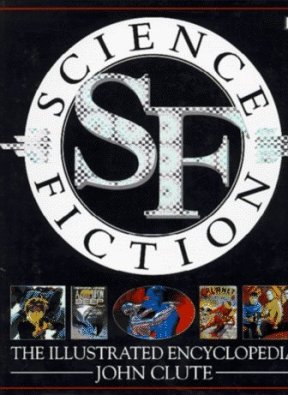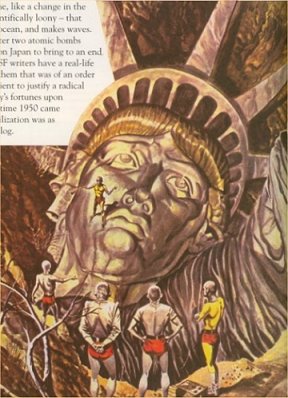|
|
|


<<< Continued from previous page
Science Fiction: The Illustrated Encyclopedia

Science Fiction: The Illustrated Encyclopedia (New York: Dorling Kindersley, 1995; 0789401851), also edited by John Clute, is a closely related title. Quite simply, it's a visual treat, and it includes some extraordinary bonus features for SF book collectors and scouts. The information is broken out in sections: Future Visions, Historical Context, Influential Magazines, Major Authors, Classic Titles, Graphic Works, Genre Film, and International Television. Content is presented in chronological order with a lavish use of timelines.
- Historical Context.
The timeline approach is particularly interesting in the Historical Context section; it visually
relates SF events (arranged by Book, Magazine and Film/Radio/Television) to World Events.
The Historical Context section also makes good use of the themes approach. There are 19
double-page entries - e.g., Time Travel, Alternate Worlds, Future Histories, Future Wars, etc. -
each consisting of textual content and carefully chosen images that tie SF elements to the given
historical period. "After the Apocalypse," for example, appears after the 1950 timeline.
The article explores the relationship between the 1945 atomic bombings of Hiroshima and Nagasaki
and the hydrogen bomb tests at Eniwetok and Bikini Atolls and the theme of post-holocaust novels
such as George R. Stewart's Earth Abides and Walter M. Miller's
A Canticle for Liebowitz. Several striking images accompany the article, including a
reproduction of a color SF magazine illustration of explorers crawling over the head of a shattered
Statue of Liberty. The caption reads, in part: "... as an image, she is both profoundly
irresistible and profoundly fragile." And is there anyone alive who is not familiar with the
final scene in the original movie version of Planet of the Apes?

- Major Authors.
Both the Major Authors and Classic Titles sections contain several important features for the collector and scout. The Major Authors section is liberally illustrated with color front cover photos of more than 150 titles. Each entry includes a photo/illustration of the author as well as a critical examination of the author's importance. Typical of the treatment is the following: "[Frank] Herbert, like most people with big ideas, sometimes found that words failed him, and so used too many of them." Bibliographic sidebars also appear. Titles are categorized by type - e.g., Novel, Short Story Collection, Non-Fiction, etc. - and appended with publisher and year of publication. (A complaint: it would have been helpful to indicate format - hardback, paperback, etc.) Finally, each entry includes a reproduction of the author's signature - a nice bonus.
- Classic Titles.
The Classic Titles section features over 100 key titles in SF publishing history, beginning with
Mary Shelley's Frankenstein (1818) and ending with Theodore Sturgeon's
The Ultimate Egoist (1994). On average, each page in this section features three to
five books, with each entry bearing a color photograph of the front cover. The introduction
to this section warns that in some cases the photo "may be from a later edition."
From a collector/scout point of view, it would have been helpful for Clute to label these.
Some are easy to spot, such as the entry for John Brunner's Stand on Zanzibar, identified in the caption as Doubleday 1968, but with a photo that clearly shows Macdonald as the publisher. Again, publisher and year of publication appear; key format information does not, though this is mostly a hardback issue - that is, paperbacks often bear book ID numbers and prices on the front cover.
Still, even with the noted faults, the Major Titles section is a great resource for the book collector and scout. Think of these as a set of flash cards that you can use to train your eye; time spent going over the photos on these pages could well be rewarded later at a thrift store or library sale. And here's the best part: though out of print, this title is easily found used online for under $20.
Buy it here.
|
|


|


